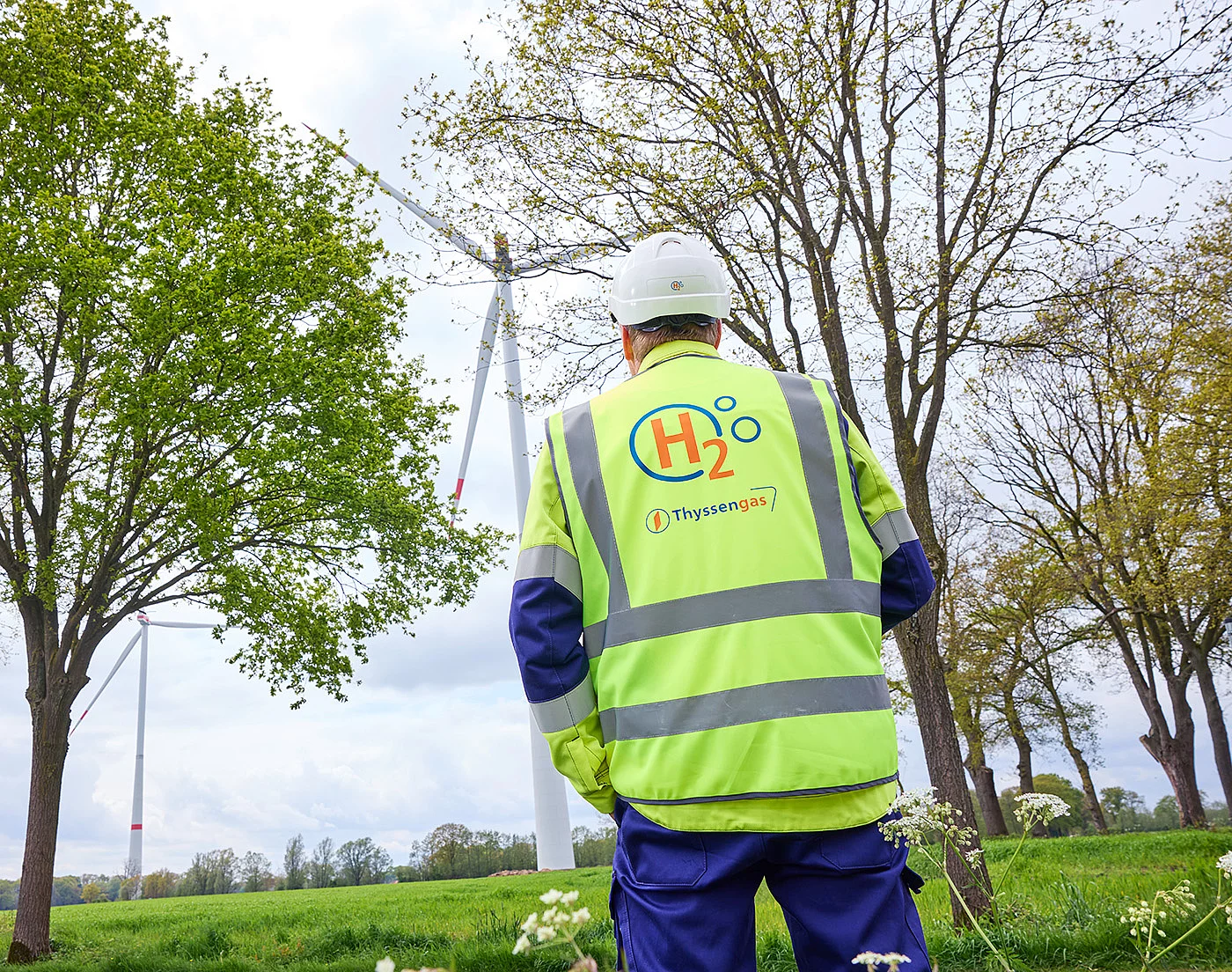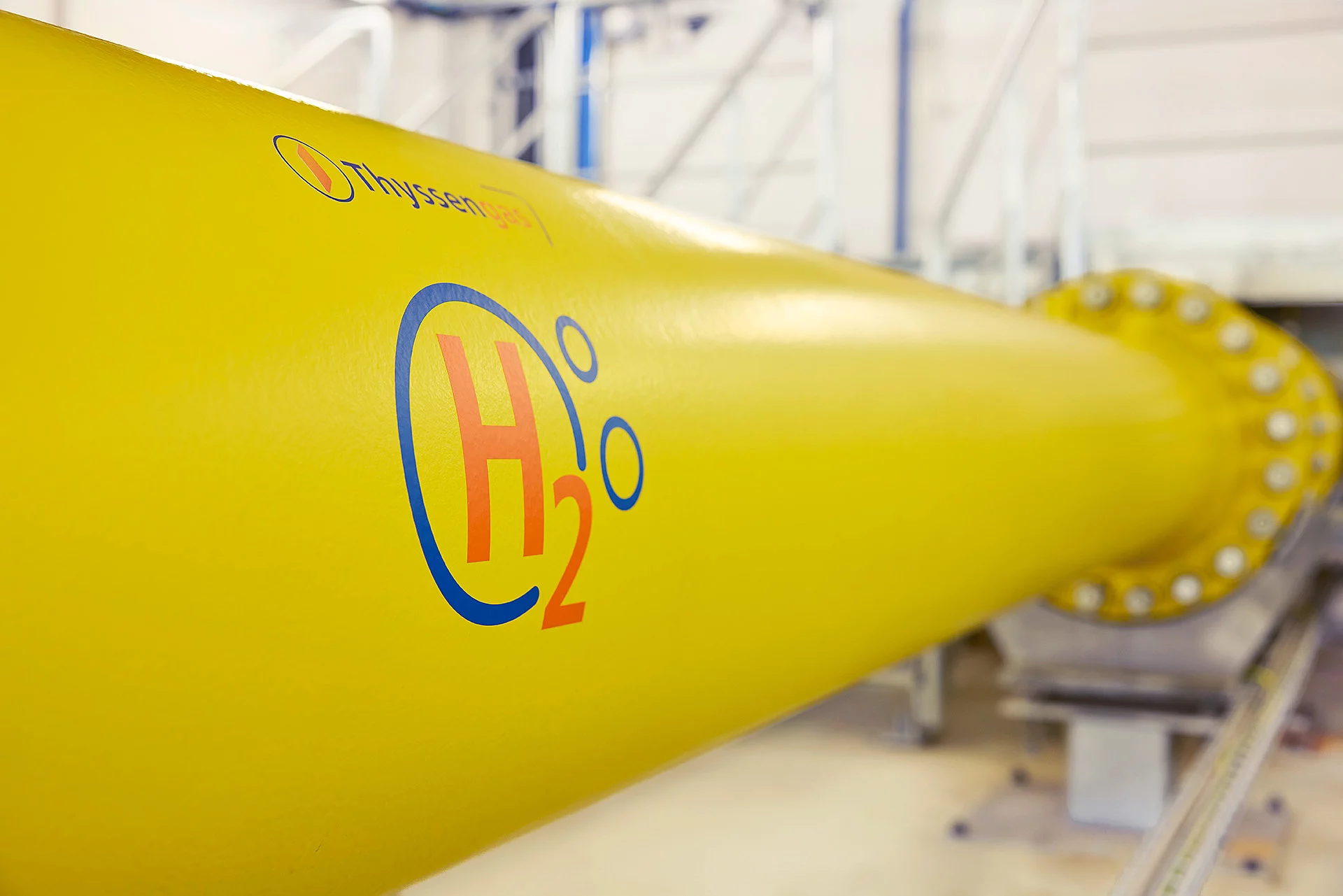The energy source of the future
Hydrogen as a key element.
Hydrogen (H₂) is the beacon of hope on the road to a decarbonised energy world.
This is because hydrogen can be produced in a climate-friendly way and burns CO2-free. The current geopolitical situation has made the need for action extremely urgent. If we want to become less dependent on Russian natural gas, continue to supply the economy and households securely and affordably and at the same time reduce CO2 emissions, we need to accelerate the ramp-up of hydrogen now.
One thing is certain: Germany's future energy requirements cannot be met without gaseous molecules. Not only large-scale consumers such as steel and chemical plants, but also many medium-sized production companies in particular will not be able to switch their processes completely to electricity. They are therefore still dependent on gaseous energy sources.
The obvious solution is hydrogen. By adding hydrogen to the natural gas grid, CO2 emissions can also be reduced in the heating market without the need for complex and cost-intensive conversions.
Green, blue, grey - why does hydrogen have different "colours"?
Hydrogen itself is completely colourless. The colour attributes make the different production processes clear. This determines how climate-friendly the hydrogen is. Grey hydrogen is produced by steam reforming fossil fuels such as natural gas. The natural gas is split into hydrogen and CO2. The CO2 released into the atmosphere means that grey hydrogen is not climate-neutral. Blue hydrogen is also produced by steam reforming. However, if the CO2 is not released into the atmosphere but is either stored or utilised in industry, this is referred to as climate-neutral blue hydrogen. Green hydrogen is produced by electrolysis. This involves using electricity to split water into hydrogen and oxygen. As the electricity only comes from renewable energy sources, such as wind power or solar energy, and no CO2 is released during production, green hydrogen is completely climate-neutral. Turquoise hydrogen is produced through the thermal splitting of methane, known as methane pyrolysis: this does not produce CO2, but solid carbon. If this is permanently bound and the pyrolysis is carried out using renewable energies, turquoise hydrogen is also climate-neutral.
Electrolysis - what is it actually?
Green hydrogen is produced by electrolysis. Electrolysers are devices that use electricity to convert substances. To obtain hydrogen, a process known as water electrolysis takes place, in which water (H2O) is split into its components hydrogen (H2) and oxygen (O). This process - the production of synthetic gases using electricity - is known as "power-to-gas".
Hydrogen is considered the key element for a successful energy transition, provided it is produced in a climate-neutral way. This works by placing the electrolysers in places where renewable energy is generated - for example, near large photovoltaic systems or wind farms. The hydrogen produced using renewable energy can then be transported onwards via the existing natural gas grid with only minor adjustments, making it usable in many places.
What types of electrolysis are there?
The variants include the alkaline electrolyser (AEL), the proton exchange membrane electrolyser (PEM), the high-temperature electrolyser (HTEL), the nickel-iron electrolyser and the zero-gap electrolyser. The main differences lie in the electrolytes used, the efficiency, the operating temperature and the design of the electrolysis cell.
What is the difference between hydrogen and natural gas and what does this mean for transport?
Hydrogen and natural gas differ in their physical properties. Hydrogen is a molecule consisting of two hydrogen atoms. Natural gas, or more correctly methane, is a larger molecule and consists of one carbon and four hydrogen atoms. Due to its lower density, hydrogen contains around a third less energy per volume than natural gas. However, because the molecule is also significantly lighter than methane, the gas can flow through the pipeline more quickly. This means that large amounts of energy can still be transported.
Why is THYSSENGAS converting existing gas pipelines for hydrogen transport?
Hydrogen is gaseous and can be stored in the same way as natural gas and transported to consumers via pipelines. Thyssengas has an extensive network with around 4,400 kilometres of pipelines. In principle, it makes no difference to these pipelines whether natural gas, biogas or hydrogen flows through them.
Converting existing pipelines for the transport of hydrogen is advantageous over completely new construction for a number of reasons: firstly, conversion can be achieved much more quickly - the effort involved is much lower, not only in terms of construction work, but also with regard to formal matters such as authorisations. Accordingly, the conversion of our lines is also much more economical, as we anticipate lower costs. According to our calculations, a grid conversion only costs around an eighth of what would have to be calculated for a new build. The conversion is also more sustainable: the impact on nature is much less and the carbon footprint is better if the lines do not have to be completely rebuilt and laid.
What technical requirements must be met for the changeover?
As hydrogen molecules are smaller than methane, they can move more easily through sealing materials. Pipeline components, such as seals on flange connections, must therefore be particularly tight. Hydrogen also has the chemical property that it can split into its atomic form at imperfections in the steel pipelines. This could cause the hydrogen to penetrate the steel and damage the material.
In concrete terms, this means that we are putting our pipelines through their paces to see whether they are suitable for transporting hydrogen and, if not, where we need to take action to make them suitable for hydrogen and ensure safe operation. In principle, however, it is technically possible to convert our gas pipelines for the transport of hydrogen.
How safe is the transport of hydrogen through natural gas pipelines?
Safety is clearly the top priority when converting our pipelines and during transport. The same safety standards must apply to hydrogen pipelines as to natural gas pipelines.
Each pipeline is checked in advance by an expert to ensure that it is suitable for hydrogen. Specific measures for the conversion are defined - e.g. measurements of the pressure curve or specific maintenance intervals - which are checked by an expert before commissioning. It goes without saying that we comply with the applicable regulations such as the Energy Industry Act and the Ordinance on High-Pressure Gas Pipelines.
Incidentally, the switch from natural gas to hydrogen is not the first one Thyssengas has had to master. In the course of our more than 100-year company history, the energy sources have changed again and again: from coke oven gas to natural gas to biogas - and in future hydrogen.

